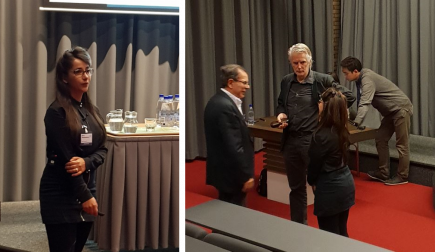Dutch Zeolite Association prize for COMOC research group

(19-10-2018)
Sara Abednatanzi wins the DZA prize for best oral presentation
Sara Abednatanzi, a PhD student at the COMOC research group of Pascal Van Der Voort, has won the Dutch Zeolite Association (DZA) prize for best oral presentation at the Dutch Zeolite Association meeting which took place on October 11th in Amsterdam. She was congratulated by Avelino Corma and Freek Kapteijn for her talk on covalent triazine framework (CTF) assisted aerobic alcohol oxidation.
Presentation abstract
Although heterogeneous catalysis has the advantage of easier work-up, recyclability and stability, issues related to lower catalytic activity and efficiency compared to their homogeneous counterparts restrict their potential applications. An effective strategy for enhancing the stability and activity of catalysts is combining the advantages of homogeneous and heterogeneous catalysis by immobilization of active species on efficient solid supports. In fact, the influences of the catalyst supports (surface area, diffusion of reactants, chemistry and nature of the support, etc.) have a direct impact on the catalytic activity, which is less explored. In this work, a covalent triazine framework (CTF) as support for a RuIII complex is compared to the well-known UiO-67 Metal-Organic Framework (MOF). Both catalysts were synthesized under the same reaction conditions and showed similar structural properties (Ru loading and microporous nature). RuIII@CTF proved to be a very active and selective catalyst for the aerobic oxidation of benzyl alcohol under green conditions, however, RuIII@UiO-67 did not exhibit comparable activity. For the RuIII@CTF catalyst, using only a Ru loading of 0.5 mol% and oxygen as sole oxidant, a much higher catalytic performance was obtained in comparison to other immobilized RuIII-based catalysts with periodic acid and iodosylbenzene as non-green oxidants. Several techniques showed important similarities and differences between the RuIII@CTF and RuIII@UiO-67 catalysts. Our results indicate that the unique composition of CTF having intrinsic N-heterocyclic moieties (pyridinic, pyrrolic and graphitic) is beneficial for enhancing the catalytic activity that could further activate oxygen and/or substrate on the surface of the CTF support, while the specific surface area does not play a crucial role.
Contact
Pascal Van Der Voort: pascal.vandervoort@ugent.be
Sara Abednatanzi: sara.abednatanzi@ugent.be